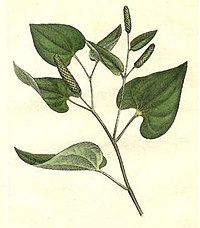
Photo from wikipedia
MADS domain transcription factors play roles throughout the whole lifecycle of plants from seeding to flowering and fruit-bearing. However, systematic research into MADS-box genes of the economically important vegetable crop… Click to show full abstract
MADS domain transcription factors play roles throughout the whole lifecycle of plants from seeding to flowering and fruit-bearing. However, systematic research into MADS-box genes of the economically important vegetable crop pepper (Capsicum spp.) is still lacking. We identified 174, 207, and 72 MADS-box genes from the genomes of C. annuum, C. baccatum, and C. chinense, respectively. These 453 MADS-box genes were divided into type I (Mα, Mβ, Mγ) and type II (MIKC* and MIKCC) based on their phylogenetic relationships. Collinearity analysis identified 144 paralogous genes and 195 orthologous genes in the three Capsicum species, and 70, 114, and 10 MADS-box genes specific to C. annuum, C. baccatum, and C. chinense, respectively. Comparative genomic analysis highlighted functional differentiation among homologous MADS-box genes during pepper evolution. Tissue expression analysis revealed three main expression patterns: highly expressed in roots, stems, leaves, and flowers (CaMADS93/CbMADS35/CcMADS58); only expressed in roots; and specifically expressed in flowers (CaMADS26/CbMADS31/CcMADS11). Protein interaction network analysis showed that type II CaMADS mainly interacted with proteins related to flowering pathway and flower organ development. This study provides the basis for an in-depth study of the evolutionary features and biological functions of pepper MADS-box genes.
Journal Title: Genes
Year Published: 2022
Link to full text (if available)
Share on Social Media: Sign Up to like & get
recommendations!